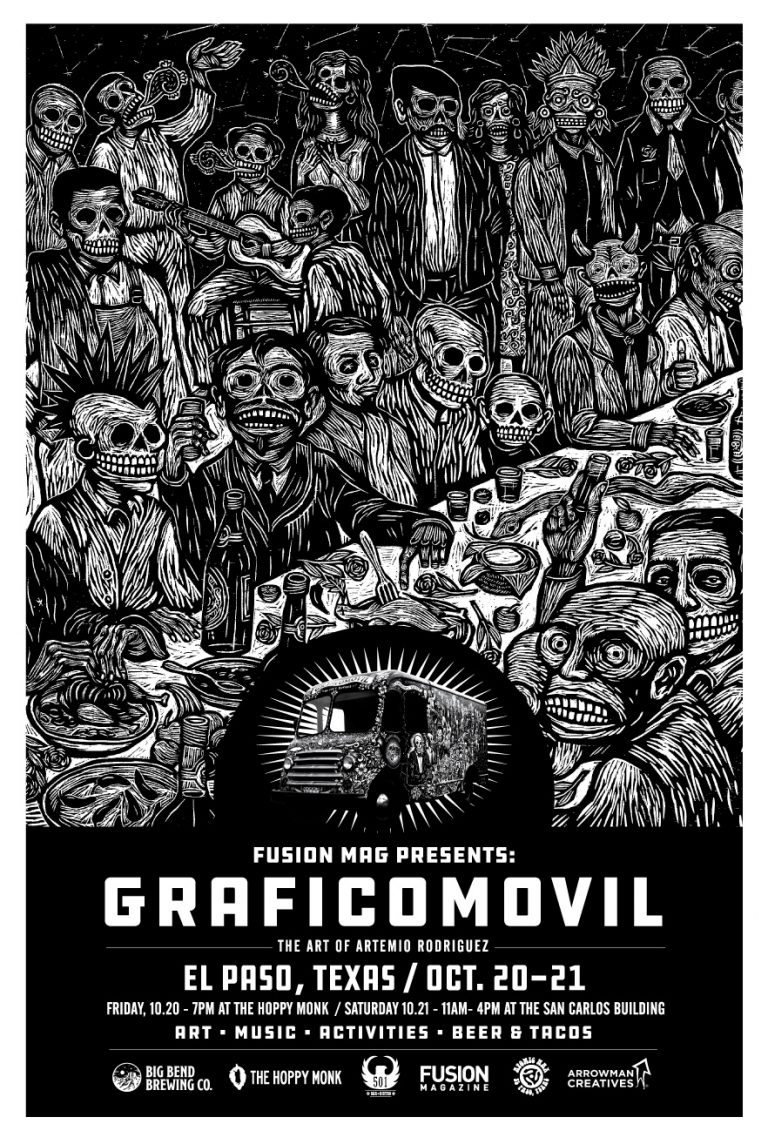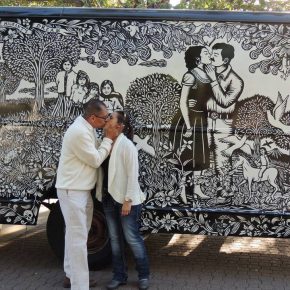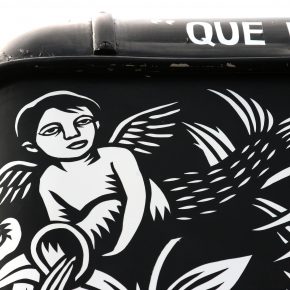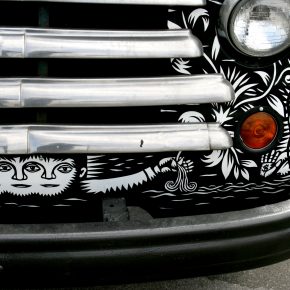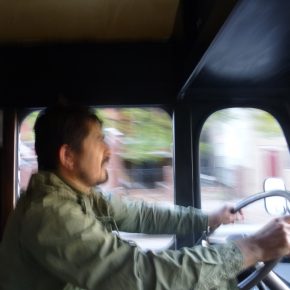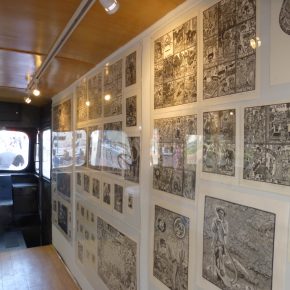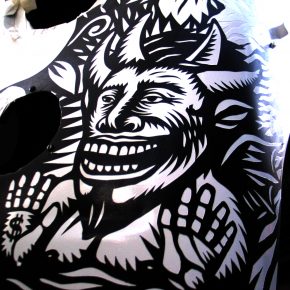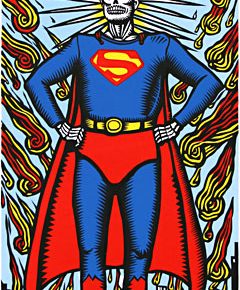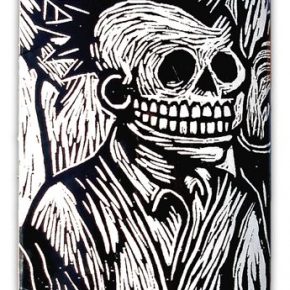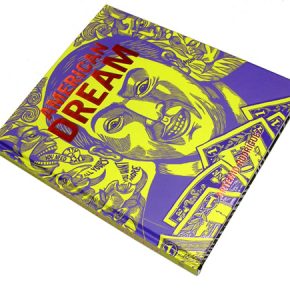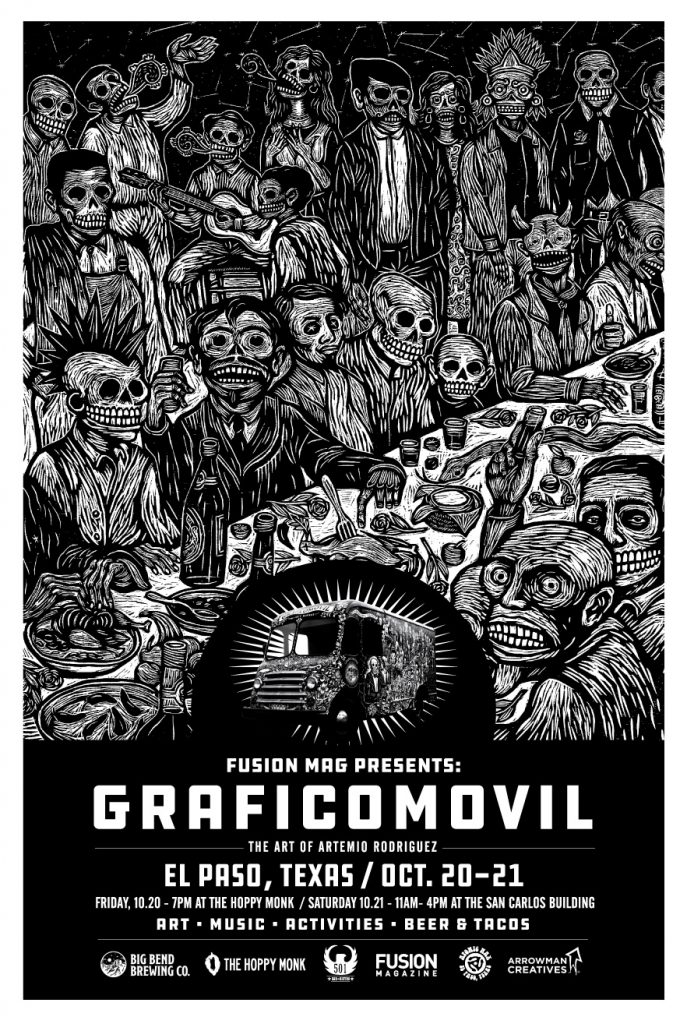
__________
Fusion Magazine presenta: El Graficomóvil del artista del grabado Artemio Rodríguez en su gira “Over the Wall”, El Graficomóvil visitara nuestra ciudad después de haber pasado por estados como California, Kansas, Colorado y varios museos en su trayecto. La cita es este 20 de Octubre en The Hoppy Monk y el 21 de Octubre en The San Carlos Building donde le daremos su debida despedida en El Paso, Texas, antes de pasar rumbo a México. En estos lugares podrán ver esta obra de arte móvil y ver su interior con obras de Artemio Rodríguez, habrá arte, venta de obra, comida y música, ¡todos invitados!, entrada libre.
Conoce esta gran obra gráfica antes de llegar a su hogar final en Pátzcuaro, Michoacán.
Este evento es orgullosamente patrocinado por: Big Bend Brewing Co, The Hoppy Monk, The San Carlos Building, 501 Bar & Bistro, Atomic Wax, La Mano Press, Enrique Barrios, Arrowman Creative & Fusion Magazine.
Graficomovil pays homage to the complex and innovative history of printmaking and the graphic arts. This truck is a mural, a gallery, a printmaking studio, and a library on wheels. Graficomovil is designed to go to schools, parks, community art centers, museums, and other public places to engage people with art.
The work of Graficomovil
So now, ten years after the idea of Graficomovil was first conceived, it gives us great pleasure to know it has been a part of diverse communities – from those in the Los Angeles area, to those in Colorado, and now in Kansas. After its visit to Kansas, Graficomovil will be taken to Mexico, in something we call the “Over the Wall Tour.” After a stop in El Paso, Texas, it will cross the border to Ciudad Juarez, then go on to the city of Chihuahua. It will continue its way to Michoacan, where it will take a break, so it can have its interior re-designed and have some mechanical work done. We hope Graficomovil keeps going for a long time. We love its inspirational work. Soon, it will be encouraging art-making in and around indigenous communities in the state of Michoacan, as well as visiting other places around Mexico. What other lives will it have? We’ll see…..
Artemio Rodríguez
La idea del Graficomóvil de Artemio Rodríguez nace con la necesidad de mostrar y llevar el arte del grabado a las calles y otros lugares públicos, difundir el oficio del grabado y de la imprenta; tal vez vender algo de obra y libros, para continuar con el proyecto. Así que el interior del Graficomóvil albergaría una mezcla de taller de grabado, imprenta, biblioteca y tienda.
El Graficomóvil ha recorrido y visitado escuelas, ferias, iglesias, museos, festivales, universidades y otros espacios públicos a lo largo de EUA. Después de una larga estancia en Denver y de visitar gran pare del estado de Colorado, en 2017 el Graficomóvil fue invitado por el Museo de Arte de la Universidad Estatal de Kansas para formar parte de una exposición y visitar diversos lugares del estado. En octubre de ese mismo año la estancia del Graficomóvil en Estados Unidos llegara a su fin. La siguiente parada sera El Paso, Texas.
El objetivo principal del Graficomóvil es llevar, literalmente, el arte a la gente; crear un carro que fuese atractivo para niños, jóvenes y adultos. Mostrar obras de arte, hacer demostraciones, difundir el oficio del grabado y de la imprenta; crear un carro que fuese atractivo para niños, jóvenes y adultos. Mostrar obras de arte, hacer demostraciones pero sobre todo crear una interacción con el público. Dicen que el arte habla por sí mismo; este arte no sólo habla, sino que se desplaza por el mundo por sí mismo. De algún modo, consigue que lo lleven de acá para allá, para seguir haciendo su trabajo de repartidor, ya no de lámparas, como en los años cincuenta, sino de arte, conciencia, ideas, convivencia, inspiración, y demás.
-Rafael A. Revilla
Graficomovil
The 1948 Chevy delivery truck originally belonged to J.G. Holzgang Co., and was used to deliver lamps in the Los Ángeles Area. Dating from the 1930s, the company closed down in December of 1964. The truck was passed to a former company employee named Luis Uguiarte, who used the truck for selling clothes and other merchandise at local swap meets. In 1984 Mr. Uguiarte had his legs amputated due to diabetes complications. The truck ended up parked in the backyard of an East Los Angeles home. Years later Oscar Duardo, a serigraph master printer,
was given the truck in exchange for clearing the abandoned backyard. Mr. Duardo moved it to Lincoln Heights, where he used the truck as storage for screen printing inks. In 2006, Artemio Rodríguez saw the truck for first time, acquired it from Mr. Duardo, and with his help and a grant from Creative Capital, Graficomovil’s transformation began.
Preparation
After so many years of history (it still had the original paint from 1948), the truck had to be sanded down to the bare metal. After sanding and priming, the truck was painted black. A test area was covered with adhesive paper, on top of that a drawing was made, then areas were cut away to make a stencil. After this, a white coat of paint was applied and the mask was removed to reveal the stenciled design. Finally, a coat of car varnish was applied. The test worked, and later the whole truck was painted in the same manner. The whole process took several months to complete. Meanwhile the inside of the truck was also being transformed. Plywood was applied to the interior walls and gallery lights were installed. The floor was kept original, as was the inside surface of the doors.
The work of Graficomovil
So now, ten years after the idea of Graficomovil was first conceived, it gives us great pleasure to know it has been a part of diverse communities – from those in the Los Angeles area, to those in Colorado, and now in Kansas. After its visit to Kansas, Graficomovil will be taken to Mexico, in something we call the “Over the Wall Tour.” After a stop in El Paso, Texas, it will cross the border to Ciudad Juarez, then go on to the city of Chihuahua. It will continue its way to Michoacan, where it will take a break, so it can have its interior re-designed and have some mechanical work done. We hope Graficomovil keeps going for a long time. We love its inspirational work. Soon, it will be encouraging art-making in and around indigenous communities in the state of Michoacan, as well as visiting other places around Mexico. What other lives will it have? We’ll see…..
Artemio Rodríguez/Graficomovil
Graficomovil pays homage to the complex and innovative history of printmaking and the graphic arts. Graficomovil is a mural, a gallery, a printmaking studio, and a library on wheels. Graficomovil is designed to go to schools, parks, community art centers, museums, and other public places to engage people with art.
The 1948 Chevy delivery truck originally belonged to J.G. Holzgang Co., and was used to deliver lamps in the Los Ángeles Area. Dating from the 1930s, the company closed down in December of 1964. The truck was passed to a former company employee named Luis Uguiarte, who used the truck for selling clothes and other merchandise at local swap meets. In 1984 Mr. Uguiarte had his legs amputated due to diabetes complications. The truck ended up parked in the backyard of an East Los Angeles home. Years later Oscar Duardo, a serigraph master printer, was given the truck in exchange for clearing the abandoned backyard. Mr. Duardo moved it to Lincoln Heights, where he used the truck as storage for screen printing inks. In 2006, Artemio Rodríguez saw the truck for first time, acquired it from Mr. Duardo, and with his help and a grant from Creative Capital, Graficomovil’s transformation began.
Preparation
After so many years of history (it still had the original paint from 1948), the truck had to be sanded down to the bare metal. After sanding and priming, the truck was painted black. A test area was covered with adhesive paper, on top of that a drawing was made, then areas were cut away to make a stencil. After this, a white coat of paint was applied and the mask was removed to reveal the stenciled design. Finally, a coat of car varnish was applied. The test worked, and later the whole truck was painted in the same manner. The whole process took several months to complete. Meanwhile the inside of the truck was also being transformed. Plywood was applied to the interior walls and gallery lights were installed. The floor was kept original, as was the inside surface of the doors.


